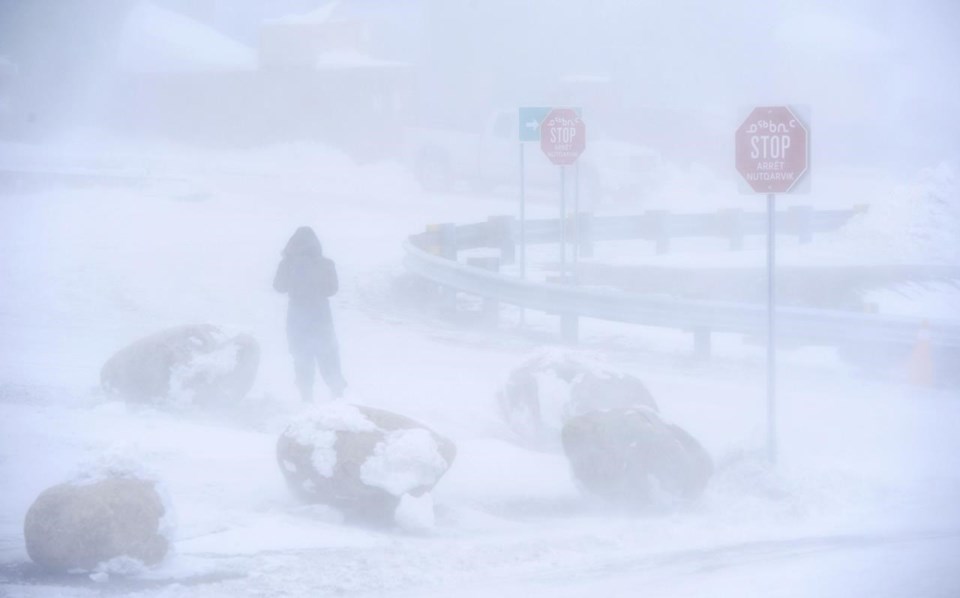Inuit Nunangat, the four regions comprising the Inuit homeland in Canada, is home to some of the country's harshest climates.
With the area's severe, cold winters and short, cool summers, weather has been intrinsically connected to Inuit ways of life, reflected in clothing, sewing or hunting patterns.
Inuit communities have had to adjust their ways of living as climate change affects their land, water and weather systems.
With this in mind, independent broadcaster Uvagut TV set out to develop hourly weather broadcasts in Inuktut in partnership with The Weather Network.
"Our weather is changing so rapidly that we don't know if there's going to be a blizzard or if the ice is safe to travel across," said Lucy Tulugarjuk, executive director of Uvagut TV.
"It's a serious matter. It can be life and death."
In 2021, Nunavut Independent Television Network, an Inuit-owned non-profit, started Uvagut TV, meaning "Our TV," becoming the first national Indigenous-language television channel in Canada.
It delivers nearly all of its round-the-clock broadcast in Inuktut, including national and regional news and children's programming.
It was also around this time that Uvagut began working with Pelmorex Corp., the international weather information and data management company that owns The Weather Network, to create four three-minute local weather forecasts announced in four Inuktut dialects.
The reports air 16 times a day in parts of the Northwest Territories, northern Quebec, Labrador and Nunavut.
The two-year project was no small feat.
Tulugarjuk had to find and work with multiple translators to provide forecasts and terminology in various dialects.
"Our translators had to go to elders and ask for specific terms that didn't exist. So, they, too, had to figure out what was the appropriate word," said Tulugarjuk.
In one case, the translators had to work with elders to come up with an equivalent to the English term "humidity."
It was also a learning experience for Tulugarjuk, who grew up in Igloolik in the Qikiqtaaluk region in Nunavut and is fluent in Inuktitut.
While that dialect is used in Labrador, Tulugarjuk said translations sometimes differed when it came to the written language.
"Even their writing system was quite different from our writing system," she said referring to the system used in Labrador.
For the crew at Pelmorex, it was the first time they tried to create a product in another language aside from English or French.
"Doing an Indigenous language is a big first step. Like starting to run before you can walk, because the languages are more complex, a lot longer words and terms and a completely different alphabet," said Kurt Eby, director of regulatory, government and affiliate relations with Pelmorex Weather Networks.
Before teaming up with Uvagut TV, The Weather Network aired Indigenous weather facts and weather stories that related to Indigenous history, but Eby said the network wanted to amp up their efforts.
"We just want to be the weather source for everyone in this land that we share called Canada."
The team worked with Uvagut TV to create tailored forecasts that include sunrise and sunset times — important to communities in the North where some experience minimal or no daylight hours in the winter. They also had to determine the best way to show syllabics on screen.
Pelmorex also worked with the developers of SIKU, a mobile app and web platform by and for Inuit. The platform provides tools and services for ice safety, language preservation and weather. The company gets some of their maps showing ice conditions from SIKU.
Eby said the company has started working with Eskasoni First Nation in Nova Scotia to create a weather report in Mi'kmaq to air on The Weather Network.
For Tulugarjuk, the ability to provide Uvagut's 600,000 subscribers with up-to-date weather information is about more than safety — it's about preserving the language.
"Our elders are passing away. They're our knowledge keepers," Tulugarjuk said. "So, us in the middle age groups are trying to capture as many words as possible, and stories and legends before they're all gone."
This report by The Canadian Press was first published Dec. 8, 2023.
Brittany Hobson, The Canadian Press




